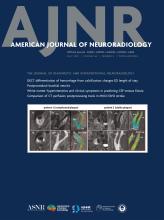Index by author
Rai, Ansaar T.
- NeurointerventionYou have accessThe Cortical Vein Opacification Score (COVES) Is Independently Associated with DSA ASITN Collateral ScoreDhairya A. Lakhani, Aneri B. Balar, Subtain Ali, Musharaf Khan, Hamza Salim, Manisha Koneru, Sijin Wen, Richard Wang, Janet Mei, Argye E. Hillis, Jeremy J. Heit, Greg W. Albers, Adam A. Dmytriw, Tobias D. Faizy, Max Wintermark, Kambiz Nael, Ansaar T. Rai and Vivek S. YedavalliAmerican Journal of Neuroradiology May 2025, 46 (5) 921-928; DOI: https://doi.org/10.3174/ajnr.A8601
Rao, Dinesh
- FELLOWS' JOURNAL CLUBHead and Neck ImagingYou have accessComprehensive Review of Inner Ear Anatomy on Photon-Counting CTDinesh Rao, John V. Murray, Amit K. Agarwal, Sukhwinder Johnny Sandhu and Pat A. RhynerAmerican Journal of Neuroradiology May 2025, 46 (5) 862-867; DOI: https://doi.org/10.3174/ajnr.A8410
Compared to traditional energy-integrating CT detectors, photon-counting CT allows greater spatial and contrast resolution of small channels containing nerves, arteries, and normal anatomy such as the cochlear cleft and cochlear and vestibular aqueducts. This review article updates the existing literature by redefining these structures in greater resolution.
Regli, Luca
- Artificial IntelligenceYou have accessAccuracy of an nnUNet Neural Network for the Automatic Segmentation of Intracranial Aneurysms, Their Parent Vessels, and Major Cerebral Arteries from MRI-TOFElisa Colombo, Mathijs de Boer, Lambertus Bartels, Luca Regli and Tristan van DoormaalAmerican Journal of Neuroradiology May 2025, 46 (5) 956-963; DOI: https://doi.org/10.3174/ajnr.A8607
Resnick, Adam C.
- Artificial IntelligenceYou have accessEmpowering Data Sharing in Neuroscience: A Deep Learning Deidentification Method for Pediatric Brain MRIsAriana M. Familiar, Neda Khalili, Nastaran Khalili, Cassidy Schuman, Evan Grove, Karthik Viswanathan, Jakob Seidlitz, Aaron Alexander-Bloch, Anna Zapaishchykova, Benjamin H. Kann, Arastoo Vossough, Phillip B. Storm, Adam C. Resnick, Anahita Fathi Kazerooni and Ali NabavizadehAmerican Journal of Neuroradiology May 2025, 46 (5) 964-972; DOI: https://doi.org/10.3174/ajnr.A8581
Rhyner, Pat A.
- FELLOWS' JOURNAL CLUBHead and Neck ImagingYou have accessComprehensive Review of Inner Ear Anatomy on Photon-Counting CTDinesh Rao, John V. Murray, Amit K. Agarwal, Sukhwinder Johnny Sandhu and Pat A. RhynerAmerican Journal of Neuroradiology May 2025, 46 (5) 862-867; DOI: https://doi.org/10.3174/ajnr.A8410
Compared to traditional energy-integrating CT detectors, photon-counting CT allows greater spatial and contrast resolution of small channels containing nerves, arteries, and normal anatomy such as the cochlear cleft and cochlear and vestibular aqueducts. This review article updates the existing literature by redefining these structures in greater resolution.
Rudie, Jeffrey D.
- EDITOR'S CHOICEBrain Tumor ImagingYou have accessDevelopment and Evaluation of Automated Artificial Intelligence–Based Brain Tumor Response Assessment in Patients with GlioblastomaJikai Zhang, Dominic LaBella, Dylan Zhang, Jessica L. Houk, Jeffrey D. Rudie, Haotian Zou, Pranav Warman, Maciej A. Mazurowski and Evan CalabreseAmerican Journal of Neuroradiology May 2025, 46 (5) 990-998; DOI: https://doi.org/10.3174/ajnr.A8580
The goal of this study was to compare AI-based volumetric GBM MRI response assessment with standardized radiologist response assessments. The AI-based volumetric response assessment yielded overall moderate performance for recapitulating most human response assessment categories (BT-RADS 1, 2, and 4) but demonstrated the lowest performance for predicting BT-RADS 3, which is likely related to the high variability of this assessment. In comparison to radiologist assessment, the AI-based volumetric GBM MRI response assessment showed comparable performance for overall survival.








